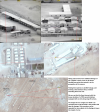Hi! I posted the reddit above, I'll add my reddit post here with my edits I've added since first posting.....
----------
Hi all,
I'm a pro photographer and video editor and I'm now certain this video is a well aimed diversion, but I do not believe its intentional by the makers of the TMZ show or corbell, but simply misunderstanding and/or possible mis-information provided to them.
I believe ETs are real and are the origin of many UAP, but this is not even a UAP I believe.
Let me give a couple of photography facts. Many security or surveillance cameras use a narrow aperture, (very small opening in the iris of the lens) in order to create a wide depth of field, so that things that are near or far are still in focus. This is also what makes security cameras more grainy, as the sensors use a high ISO (gain) to capture material at a bright enough exposure, creating the very grain we associate with them.
So with that in mind I downloaded the video.
Apart from zooming in I did one thing, I pulled back the highlights. The reason I did this was, in the brighter segments, the lightest bit of the shape almost disappear, making it look like the profile/shape is changing. Once you pull these back, then zoom in, you get this....
https://youtu.be/ZsSiVhmCGHs
To me it's clear it is on the glass housing that shields the lens, likely a fly that collided at high speed.
If you doubt my job in stills and video, check out more on the channel where I host the above. I just want this community to be able to focus on what is real and not distractions.
With good intentions,
Pete
EDIT: A quick Chatgpt shows the Wescam MX-20 is an optical thermal hybrid, meaning if for heat data it may not require use of the lens aperture, the optical components of the image certainly do!
Edit2: For those saying something on a lens (which I dont think it was , I think it was on housing), but something on a lens can be pretty sharp. See this usbc cable held againist my 24-70 touching the glass at f22.
https://www.dropbox.com/scl/fi/4dyx...1864.jpg?rlkey=k05hguk5dhjin8nsbt797pjlb&dl=0
Edit 3: My last edit, but for all the people talking about the 3d sped up timelapse. IF this is dirt on an outershell glass housing that rotates on a gimbal independently, as that glass moves, the perspective to the lens of that dirt would change, due to the distance of the housing from the lens surface combined with movement of the glass. In other words, as the glass rotates we get to see some of the dirt from a different angle.
Edit 4 - the real last one...... I've now added edits to all the main questions people had of me, its just my opinion. I've had a lot of shit for critiquing this, and thats fine, I can take it. We all have freedom to say what we feel. But if we resort to some of the things i've been referred to as, or had dms over, or messages on other platforms that are pretty vile, well thats gonna get us nowhere good. I think as a sub we are sitting on something real overall about UAPs being an otherworldly phenomena, so the idea that this place becomes a hatefest for anyone who dares to offer an unpopular opinion about a particular incident is what will make people ignore us, not ally with us.
Edit 5: So there is an edit 5! I just want to add what I've mentioned in the comments several times, its a multi lens system capable of composite imagery from lenses of more than one focal length, further expanding its DOF capability.











